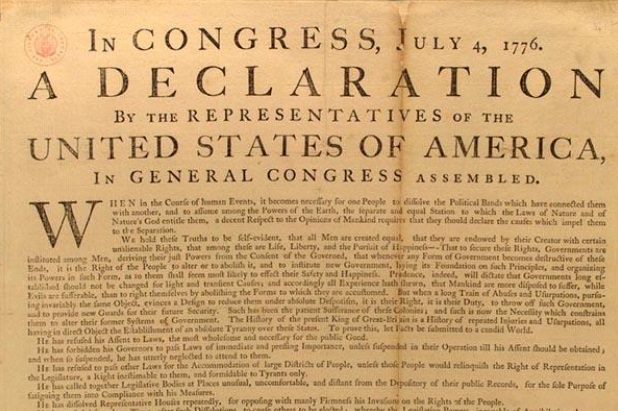
A painting at the National Portrait Gallery, highlighting the fight over the Declaration. Photo taken by Brian Carlton.
On Independence Day, Americans celebrate the Declaration of Independence, ratified by the Second Continental Congress on July 4, 1776. Virginia residents, including some locals, helped shape that document.
The Declaration of Independence was actually the “detailed” version of an earlier statement. On July 2, Congress had passed the Lee Resolution, officially resolving that the 13 colonies were “free & independent States,” separated from England. The Lee Resolution was like a politician’s speech on TV, announcing his or her plans. The Declaration then filled in the blanks, providing more depth.
The document is known as the Lee Resolution because it was proposed by Richard Henry Lee, one of Virginia’s delegates, who presented the ideas after receiving instruction from the Fifth Virginia Convention.
The Virginia Convention
This Convention, which had started meeting May 6, 1776, had already declared Virginia to be a free and independent state long before July 4.
On May 15, the Convention declared that Virginia’s government, as “formerly exercised” by King George, was “totally dissolved” in light of the king “abandoning the helm of government and declaring us out of his allegiance and protection.”
The Convention produced both the first Virginia constitution and the Virginia Declaration of Rights. These documents were sent to Richard Henry Lee and formed the basis of his resolution.
“All men are by nature equally free and independent and have certain inherent rights,” the Virginia Declaration states. “[These are] the enjoyment of life and liberty, with the means of acquiring and possessing property, and pursuing and obtaining happiness and safety.”
If that sounds similar to the Declaration of Independence, it’s not by accident. Thomas Jefferson used Virginia’s Declaration as a template when crafting the later document. In fact, the Virginia Declaration can be considered the first modern constitutional protection of individual rights for citizens in North America. It rejected the idea of privileged political classes or hereditary offices.
Virginia’s declaration went beyond that – also rejecting any type of religious test.
“Religion, or the duty which we owe to our Creator, and the manner of discharging it, can be directed only by reason and conviction, not by force or violence,” the document states. “Therefore all men are equally entitled to the free exercise of religion, according to the dictates of conscience and that it is the mutual duty of all to practice Christian forbearance, love and charity toward each other.”
Local Voices Speak Up

Here’s where local voices come in. While Danville didn’t yet exist, Pittsylvania County did. Both Benjamin Lankford and Robert Williams represented the area at the Convention, casting votes in support of freedom and this new state constitution.
Lankford was Pittsylvania County’s first sheriff, appointed by the governor in 1767. We think of sheriffs today as just law enforcement officials. But in the late 1700s, a sheriff in Virginia was “the leading executive officer of the county,” said historian David Fischer. In his 1989 book, British Folkways in America, Fischer explained that a Virginia sheriff’s job was to “organize the courts, impanel juries, issue writs, call elections, read royal proclamations, maintain the peace, protect the church, administer judicial punishments, run the jail, and keep the county’s records.”
Lankford’s fellow Pittsylvania delegate, Col. Robert Williams, was a well-known lawyer in the area. Originally from North Carolina, he served as a colonel in the local colonial militia during the Revolution. Before long, he was named chairman of the Pittsylvania County Committee of Safety. In his book, Fischer says Williams “had title to many acres and perhaps epitomized the Pittsylvania landed gentry.”
Both Williams and Lankford voted in support of creating Virginia’s Declaration of Rights (and the state constitution).
A Virginia Resolution
The text adopted by Williams and Lankford, along with the rest of the Convention, was what Richard Henry Lee brought before the Continental Congress, presenting it almost verbatim. As Congress considered Lee’s resolution, the group agreed to form a committee to craft an official Declaration of Independence. This would be voted on if Lee’s resolution passed.
That committee consisted of Thomas Jefferson, John Adams, Ben Franklin, Roger Sherman and Robert R. Livingston. The Declaration was meant to go into detail, explaining the intent and thoughts behind the Lee Resolution. The committee spent 17 days writing it, beginning on June 11 and finishing on June 28. Lee’s Resolution was officially adopted July 2 and, two days later, the Declaration itself was approved.

P.O. Box 6
Danville Va. 24543
(434) 770-1386
danvillehistorical@gmail.com
danvillehistory.org
@DanvilleHistoricalSociety
Learn about the author at https://ncvamedia.com/authors/brian-carlton/































































































